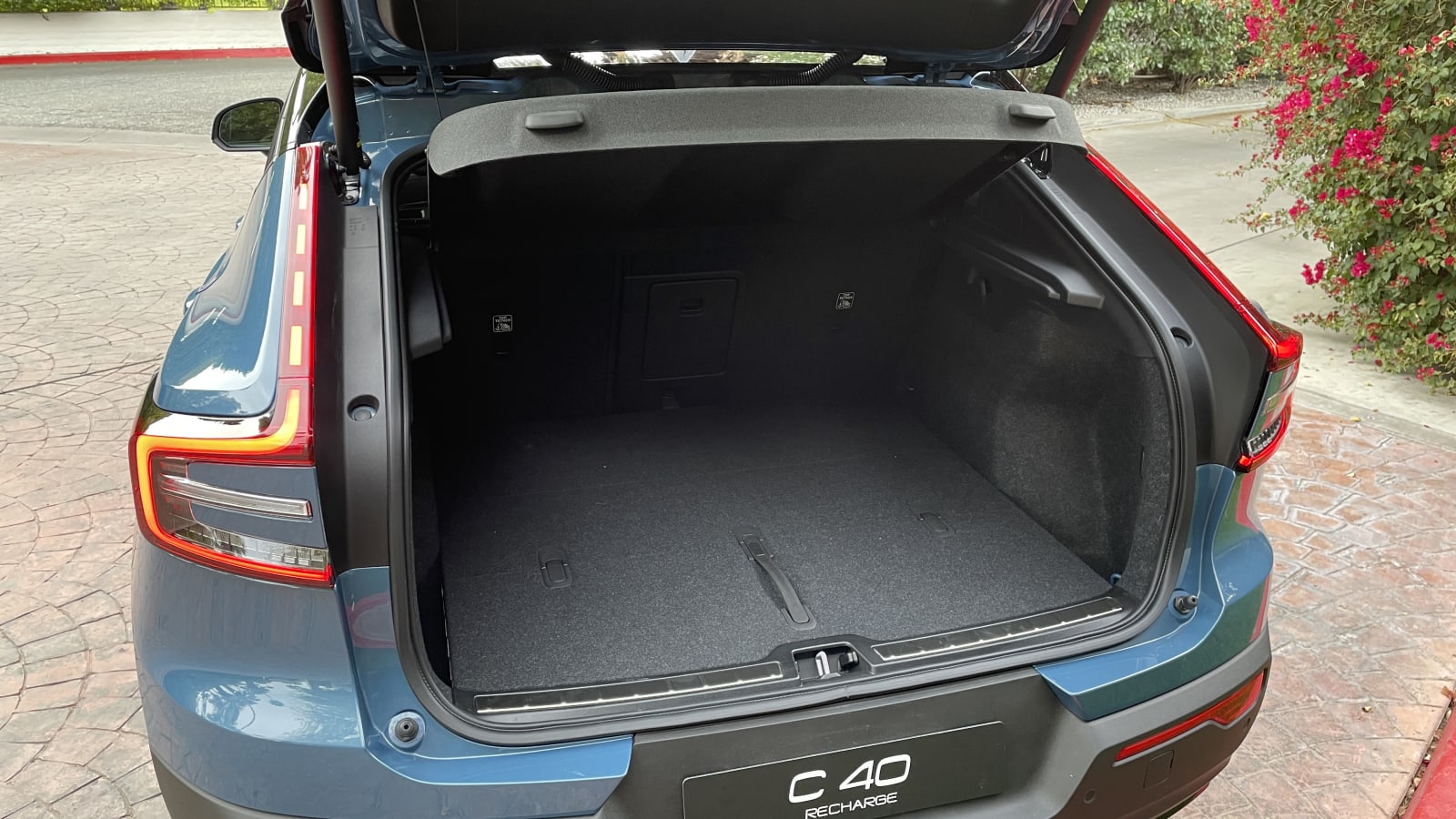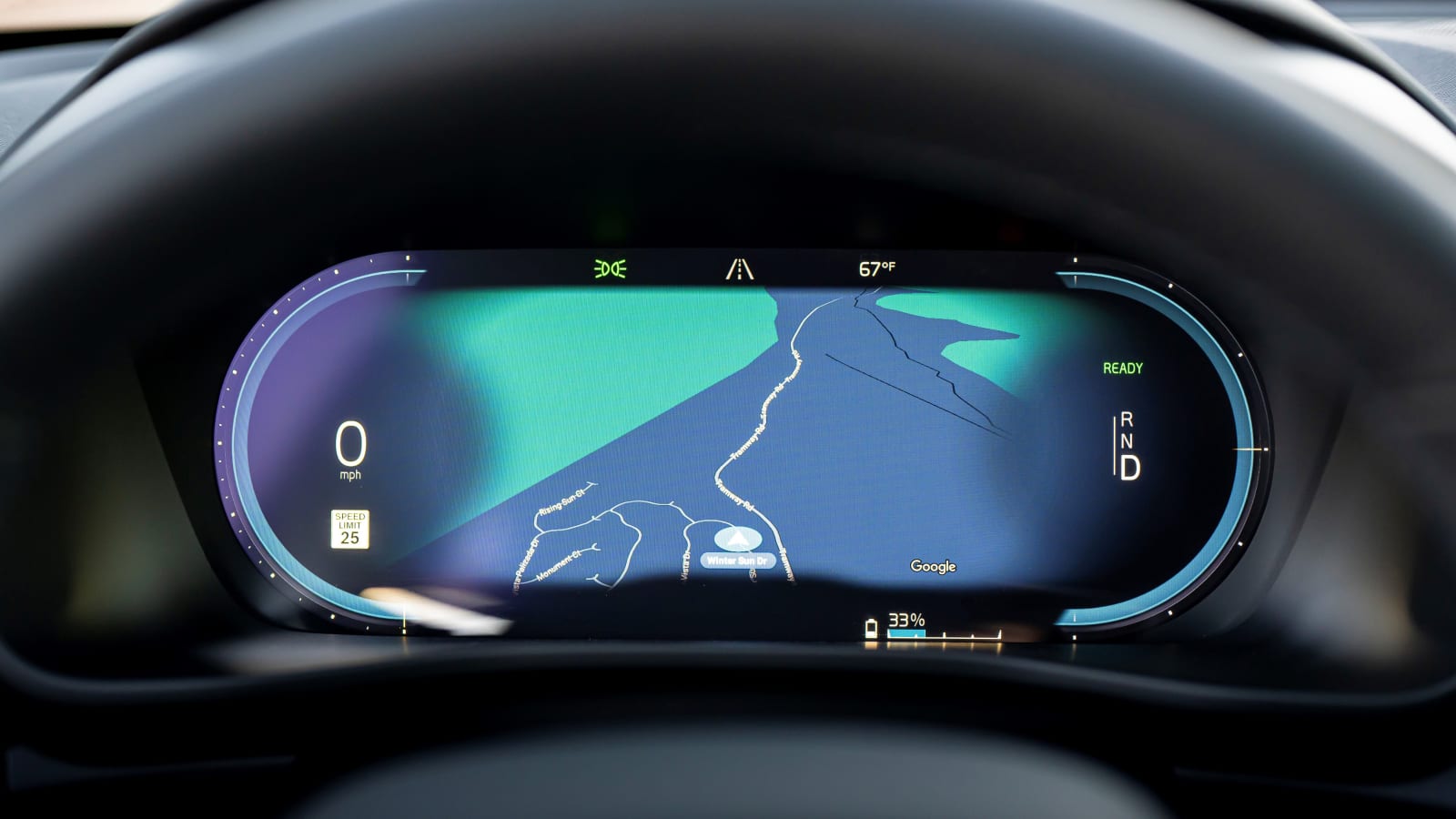PALM SPRINGS, Calif. — Volvo doesn’t rock the design boat often, but the 2022 Volvo C40 Recharge is an exception to the Swedish car company’s staid, yet handsome norm. The C40 is a fully-electric crossover coupe, and it is Volvo’s first vehicle to adopt this fastback shape. Not only that, but it’s also Volvo’s second electric car, following closely on the heels of the XC40 Recharge, a vehicle we’ll drive soon.
With the C40 Recharge being a new shape for Volvo, the design and technology teams are using it to debut some new ideas both inside and out. The rear end features new LED taillight technology from Volvo that features segmented LEDs and sequentially activating turn indicators for a different look than the typical fully-lit Volvo taillight. Its grille is debuting a new “Iron Mark” that houses a brand-new (and improved) suite of radar for the driver assistance systems — the logo is also now heated to ensure that neither ice nor snow buildup will stop the systems from functioning.
As for the crossover coupe part of this design, you’ll notice the rear is full of spoilers. Volvo’s head of design, Eric Beak, tells us that the dual, fin-like rooftop spoilers are there as aerodynamic aids in a bid to increase range. Meanwhile, the big spoiler jutting out on the car’s trailing edge is designed to give the car greater stability at high speeds by reducing lift. The 20-inch wheels you see pictured here are the only option, so hopefully you like them. We do, and we like the look of this car overall. Photographs don’t properly capture the angularity and shape of the body panels, but the C40 is a striking crossover coupe when you get up close to it.
What could ultimately be even more controversial than the exterior design are the interior material choices. You won’t find an inch of leather covering the C40’s interior. Instead, Volvo is focusing on sustainable materials made using recyclables. For example, the seats are constructed of Volvo’s suede-like Microtech material that is made of recycled polyester. Ditching leather is great, so long as the replacement is suitable for a luxury vehicle at a luxury price, and in this case, it works in nearly every area. Our one complaint is the steering wheel, for the synthetic leather substitute used here feels too much like plastic and is nowhere near as nice or supple to hold as quality leather is.
When it comes to driving and charging the C40, the experience is a vaguely familiar one. The platform underpinning this car is Volvo’s Compact Modular Architecture (CMA) that also underpins the Polestar 2 and XC40 Recharge. For the C40’s first model year, it comes in one battery configuration: a liquid-cooled 78-kilowatt-hour lithium-ion pack that has 75 kWh of usable energy storage capacity. Per EPA testing, this nets you 226 miles of range with a full charge. That’s 3 miles more than the XC40 Recharge, but 23 miles less than the dual-motor Polestar 2. Various other all-wheel-drive EVs from other companies offer even more range than that. Charging speed maxes out at 150 kW when plugged into a DC fast charger, allowing you to go from 0-80% charge in about 40 minutes. If you’re lucky enough to be located nearby, we’d recommend trying out Volvo’s new Starbucks chargers in the Pacific Northwest.
Smashing the throttle on the C40 is enough to snap anybody to attention instantly. Once again, only one drivetrain/motor configuration is available: each axle gets an identical motor, therefore making the C40 an all-wheel-drive crossover. Volvo hasn’t announced a single-motor front-drive model yet, but considering its existence on other CMA models, it could easily be introduced here, as well. The two motors combine for a total system output of 402 horsepower and 486 pound-feet of torque. Despite the C40’s prodigious 4,817-pound curb weight, that power is still enough for a 0-60 mph time of just 4.7 seconds. Similar to all Volvos now, top speed is electronically limited to 112 mph.
Volvo doesn’t try to break your neck off the line, but acceleration picks up rapidly after the initial shove. Where the C40 will try to give you whiplash are full throttle applications made when already in motion. The experience is similar to pretty much any other powerful EV. Put your foot down, and there is zero delay. An artificial light hum is piped into the cabin, but Volvo avoided the sort of loud futuristic noises that fill other EVs. Even when you’re charging up a steep mountain pass, the C40 will always be glad to quietly pin you to the seat.
Handling on the switchbacks up said mountain pass outside Palm Springs is respectable, but don’t go thinking that this car is a Polestar just because it shares its platform with one — there are no Öhlins dampers to be found here. Yes, the under-floor battery gives the C40 a lovely, low center of gravity, but it still doesn’t fully disguise the weight. You can feel this car’s mass as you build g’s through a long corner or when it doesn’t seem as thrilled to slow down headed downhill as you’d expect for its dimensions. Big 255-section-width tires impart a stable and planted feeling through corners, but you’ll run out of grip quickly if you devote too much trust in those Pirellis. A Polestar 2 is considerably more fun to drive.
There are no drive modes — only a toggle to “stiffen steering feel” — so it’s mostly one size fits all, and the single size largely works. Of all the areas of possible improvements, the most impactful change could likely be made in the balance of power delivery. As it stands, the front wheels often have far more torque directed to them (despite it being a 50/50 torque split at all times) than you might want, inducing torque steer and disrupting your rhythm. The C40 dumps its power when you tell it to, but there’s enough of it there that a limited-slip differential or a torque vectoring system would be highly beneficial to enthusiastic driving.
Around town cruising is largely pleasant, as the C40 has a quiet cabin, and its one-pedal driving mode works wonders. We can’t tell you how it rides on poor roads thanks to Palm Springs’ excellent pavement quality, but that question will be answered when we get a C40 on our own Michigan turf.
The one nagging annoyance that comes standard in driving the C40 is its supercar-like rear visibility. Looking through the tiny window in the mirror is like looking through a mail slot, and while it didn’t rain during our time with the car, we suspect the lack of a rear wiper will deteriorate winter and rain vision even worse. You do have the option of a 360-degree camera for low-speed maneuvering, but few cars are begging for a digital rearview mirror more than this one.
Despite the C40’s small stature and sloping roofline, utility still gets decent marks for a little crossover coupe. The rear seat is downright spacious in both leg- and headroom, with the latter being the real surprise. Your 5-foot-10 author didn’t even come close to brushing the roof in the rear seat. And while cargo space is affected negatively versus the XC40 Recharge, it’s not a terrible loss at only 1.4 cubic-feet less. A tiny frunk exists, but it can’t hold much beyond the charging cable.
Like other Volvos in the lineup, the C40 adopts the latest version of Google’s Android Automotive OS infotainment system to display on the 9-inch touchscreen. It doesn’t support Apple CarPlay at launch, but Volvo says it will arrive via an over-the-air software update this year. Even with the omission, this infotainment is an excellent one to use with Google Maps as the native navigation system and Google Assistant for voice commands.
We’re slightly miffed to see some button controls disappear and wind up in the screen, such as Volvo’s Pilot Assist driving assistant activation — now it takes several button clicks to turn this on or off versus a simple steering wheel toggle in other Volvos and other brands. On the bright side, Volvo’s 12.3-inch digital gauge cluster is a winner with crisp graphics and a helpful Google Maps display in the center.
Volvo has made any trim discussion unnecessary by choosing to offer the C40 in a single fully-loaded trim for 2022. You get to choose your exterior color and interior … and that’s it. We can heartily recommend the pictured Fjord Blue, which Volvo says is inspired by the water color of fjords in Sweden. This can then be paired with the Fjord Blue interior that nets you blue carpeting and plenty of blue interior trim. It looks spectacular, and it pairs nicely with the light-up dash trim that resembles a topographic map of Sweden’s Abisko National Park.
For $60,940, the C40 Recharge can be yours, and the full $7,500 federal tax credit applies. The feature set is largely complete, but the omission of cooled seats is a head scratcher. An XC40 Recharge with a similar level of equipment is about $1,500 cheaper, so that’s the premium you pay for the unique crossover coupe body style. There’s nothing particularly game-changing about the C40 in the EV space when it comes to the way it drives or the propulsion system, but as a style statement, it’s a compelling option. Unique characteristics like the sustainably-sourced interior, Google tech, Volvo safety reputation and relatively small size (compared to the rest of the luxury EV crossover market) make it desirable. We don’t imagine the C40 ever being a volume leader in the segment, but don’t discount it in your electric car search.
Related video:
Source: www.autoblog.com













